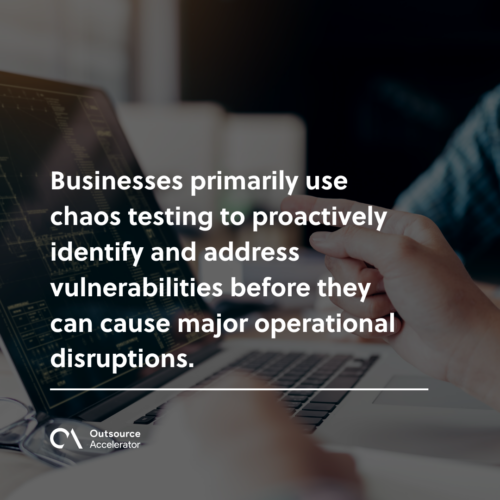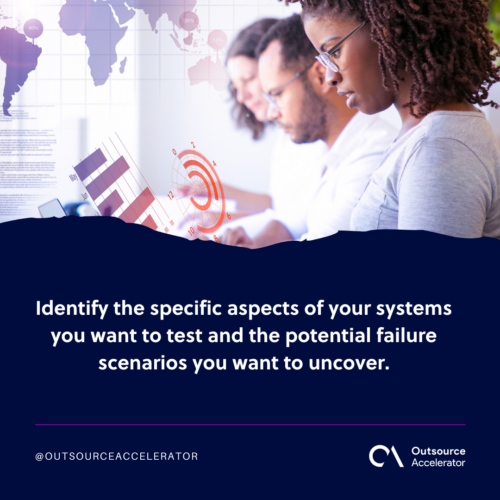Chaos testing 101: Enhancing system resilience for optimal performance

Many business models rely more on software solutions to keep their operations running smoothly and efficiently. This development is only expected as technological innovations evolve and change the business landscape.
However, the increasing complexity of the various software companies makes them vulnerable to unexpected failures and disruptions. These interruptions can negatively impact their business continuity and bring down customer satisfaction.
Implementing chaos testing can help businesses prepare for unforeseen operational disruptions. It can help these businesses proactively identify potential problems and develop mitigation strategies.
But what exactly is chaos testing, and how does it help companies prepare for operational disasters? Read below to find out.
What is chaos testing?
Chaos testing, also called chaos engineering, refers to improving software systems’ resilience and reliability. The process introduces “controlled chaos” into systems to observe how they react and identify possible weaknesses.
These controlled chaos elements can imitate real-world disruptions and system failures to test a system’s response capabilities.
Businesses primarily use chaos testing to proactively identify and address vulnerabilities before they can cause major operational disruptions.
Through chaos testing, software engineers and system administrators can better understand how their systems “behave” under stressful conditions, such as:
- Traffic influx
- Hardware failures
- Software glitches
Chaos testing is a relatively young concept. The practice was introduced in 2010 by the streaming giant Netflix as the company was migrating its entire infrastructure to Amazon’s cloud-based Amazon Web Services.
Since then, DevOps and IT teams from different industries worldwide have joined Netflix and Amazon and adopted chaos testing.

Benefits of chaos testing
Incorporating chaos testing into their processes can help businesses in several ways. These include:
Identifying weaknesses
Chaos testing allows organizations to identify weaknesses and vulnerabilities in their systems proactively. By introducing controlled chaos, teams can discover potential points of failure that might not be evident during regular testing or development.
Enhancing system resilience
By subjecting their systems to various real-world-like disruptions, chaos testing helps improve their resilience. Companies can learn to adapt and recover quickly from unexpected failures, ensuring continuous operation and minimizing downtime.
Proactive issue detection
Chaos testing helps detect and address potential issues before they become critical problems in real-world scenarios. This proactive approach reduces the likelihood of costly and damaging system failures.
Improving performance
Chaos testing helps businesses pinpoint performance bottlenecks and scalability limitations. Organizations can optimize configurations and resource allocation for better performance by analyzing system behavior under stress.
Minimizing downtime
Unplanned downtime can result in significant financial losses and reputation damage. Chaos testing helps reduce downtime by identifying and resolving potential failure points, which improves system availability.
Cost-effective risk mitigation
Chaos testing helps organizations mitigate risks early, which can be more cost-effective than dealing with the consequences of system failures after they occur.
Enhancing customer experience
A resilient system provides a smoother user experience with fewer disruptions and delays. Chaos testing helps deliver higher levels of reliability to users, increasing customer satisfaction and loyalty.
Best practices for chaos testing
When integrating chaos testing into your company’s systems, it’s best to follow proven and tested best practices to avoid unintended disruptions and ensure accurate results.
Below are some of the best practices for implementing chaos testing:
Start small and controlled
As stated earlier, chaos testing involves introducing controlled chaos. For beginners, it’s also important to keep this chaos small-scale. You can gradually increase the complexity and severity of the chaos scenarios as you gain more confidence in your testing process.
This minimizes the risks of major disruptions while giving you valuable insights into your system’s behavior.
Define clear objectives
Before beginning chaos testing, you must have a clear set of objectives you wish to achieve. Identify the specific aspects of your systems you want to test and the potential failure scenarios you want to uncover.
Having well-defined objectives will guide the testing process and help you draw meaningful conclusions from the results.
Have rollback and recovery plans
It is prudent to have recovery measures in place to quickly revert your systems to a stable state after chaos testing. This ensures that any disruptions caused by the tests can be swiftly mitigated, minimizing the impact on production systems.
Test during off-peak hours
Schedule chaos testing during off-peak hours or times of lower user activity to minimize the impact on end-users and customer experience.
Doing so ensures the tests do not disrupt critical business operations or degrade system performance during peak periods.

Why should businesses implement chaos testing?
Chaos testing is a critical practice that helps businesses stay ahead of potential challenges and keep their systems in optimal condition.
By integrating chaos testing into their development process, companies can:
- Be secure in their recovery systems
- Comply with service-level agreements
- Deliver seamless user experiences
Improving their systems’ resilience through chaos testing allows companies to minimize system downtime and enhance operational efficiency.
More importantly, chaos testing enables businesses to identify weaknesses and work on them before they can pose any problems.







 Independent
Independent




